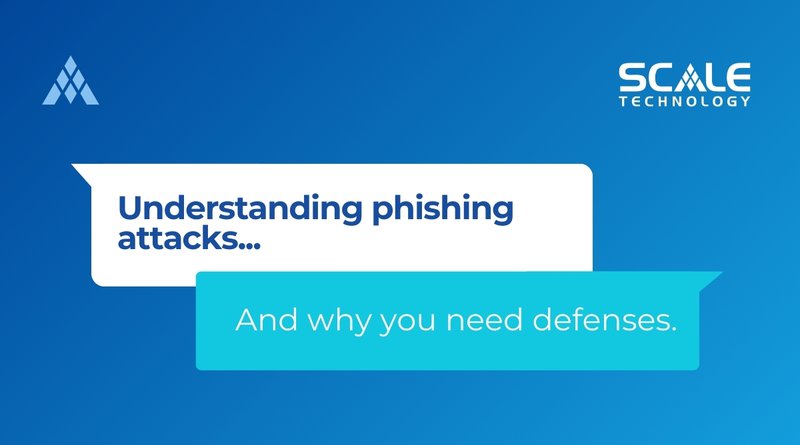Phishing attacks are more than just a nuisance—they can pose real threats to your data and your business. A single click on a fake email can compromise sensitive details, disrupt operations, or damage your reputation. The silver lining? Phishing prevention measures can help protect your information and ensure your business keeps running smoothly.
Key Points to Remember:
- What Is Phishing and Its Risks? Phishing involves deceptive messages or websites designed to steal sensitive data like passwords, account numbers, or Social Security numbers. This can lead to fraud, identity theft, and business data breaches.
- Common Phishing Methods: Scammers impersonate trusted sources, use slight domain alterations, play on urgency or fear, create poorly crafted content, and embed harmful links or attachments.
- Protective Measures: Implement multi-factor authentication (MFA), use anti-phishing tools, set up email filters, and provide employee security training, such as simulated phishing exercises. Always verify the authenticity of unknown senders or links.
- Budget Solutions for Small Businesses: Use free or low-cost email filters, browser extensions, two-factor authentication, and training tools. Establish security policies and appoint a cybersecurity contact.
- What to Do If Phished: Take immediate action by changing passwords, notifying financial institutions, reporting the incident to the FTC, and monitoring accounts for unusual activity.
- Business Strategies: Deploy email authentication tools (e.g., SPF/DMARC), phishing detection systems, and SSL encryption while fostering a culture of email security awareness.
Education and a layered defense are your best allies in staying secure.

The Dangers of Phishing
Phishing is a type of scam that tricks individuals into disclosing private information, often through convincing fake messages or websites. These scams often pretend to be official communications from trusted organizations, such as banks or online platforms, and aim to capture sensitive data like login credentials or account details.
The consequences of phishing extend beyond personal inconvenience. Once attackers gain access to your information, they can engage in fraudulent activities, such as accessing your financial accounts, committing identity theft, or selling your data to other criminals. Businesses are particularly vulnerable as phishing can expose sensitive company data, potentially resulting in financial losses or legal challenges.
Attackers often target specific individuals within businesses, such as executives, to gain access to high-value information. Their focus is on exploiting human emotions—like panic or urgency—rather than using technical hacks. For example, a scammer might send an email posing as a bank warning of “suspicious activity,” urging recipients to act immediately.
Awareness is the first step in phishing prevention. Want to know more about the latest phishing techniques? Check out current trends and preventive strategies. Additional resources, like the Federal Trade Commission's guide on protecting personal information, are also helpful.
Common Signs of Phishing Scams
Firstly, identifying the warning signs of phishing is vital to avoid falling victim. Suspicious emails or websites often contain telltale clues to make phishing prevention easier.
Recognizing Unusual Sender Names or Email Addresses
Phishing emails often disguise themselves as coming from legitimate sources. However, careful inspection of the sender's email address can reveal subtle errors. A scammer might replace one letter in an organization's domain (e.g., using “@bnk.com” instead of “@bank.com”). Hovering over the sender's name to view the full email address helps verify its authenticity.
Red Flags in Email Content and Attachments
Pay attention to email content that demands immediate action, such as “Your account will be deactivated.” Scams often contain spelling errors, generic greetings (“Dear user”), or awkwardly phrased sentences. Watch out for unfamiliar attachments or suspicious file types like “.exe” or “.zip.” Additionally, always check URLs by hovering over links before clicking. If the destination seems questionable, avoid interacting.
Want a deeper look at why raising awareness about these scams is critical? Check out this guide.
Why Scammers Use Urgency
Scammers often create a sense of urgency to manipulate victims into making impulsive decisions. For example, phrases like “Immediate payment required” are carefully crafted to bypass critical thinking and provoke quick reactions. The best response, however, is to pause, take a moment to verify the claims and resist the pressure to act immediately. By staying calm and cautious, you can avoid falling victim to these tactics.
For more information on protecting your identity, head over to the FTC's dedicated identity theft page.
Preventing Phishing Attacks
Phishing prevention requires a mix of strategies, technologies, and habits. Start by prioritizing these tactics:
Use Multi-Factor Authentication (MFA)
MFA is one of the most reliable defenses against account breaches. Besides a password, it requires another authentication factor, such as a texted code or biometric scan. This added layer makes it far more difficult for attackers to gain access. Businesses should apply MFA across critical systems, and individuals should enable it wherever available.
Leverage Technology
Anti-phishing software helps block potentially harmful content. These tools scan email messages for signs of phishing and can flag or remove threats. Additionally, many browsers offer extensions to block phishing sites proactively, ensuring safer online engagement.
Email filters are another effective tool. These filters identify and separate phishing messages before they reach your inbox. Combined with email protocols like SPF and DMARC, they improve the overall security of your digital communications.
Educate and Train Your Team
Education plays a vital role in phishing prevention. By learning to recognize fake emails and suspicious links, you can reduce your risk of falling victim. Employee training sessions, such as simulated phishing exercises, teach individuals how to handle deceptive messages safely.
Need a guide on fostering a culture of awareness? Check out this resource on improving workplace security.
Train Employees to Detect Phishing
Phishing training ensures employees become your first line of defense. Here’s how:
- Simulated Phishing Training: By sending fake phishing emails to employees, businesses can teach them to identify warning signs without actual risks.
- Create an Informed Workplace: Educate employees on email security, such as verifying links and reporting suspicious messages. Employers should encourage open communication about potential threats.
For a detailed overview, refer to the Office of the Comptroller of the Currency’s phishing prevention tips.
Steps to Take if Phished
If you fall victim to phishing, act quickly to minimize damage:
- Update Passwords: Change passwords on the affected accounts immediately and ensure they are strong and unique.
- Contact Financial Institutions: Notify your bank or credit card provider about the incident, and consider placing a fraud alert on your credit report.
- File a Report: Report the phishing activity to authorities such as the Federal Trade Commission at IdentityTheft.gov.
- Monitor for Suspicious Activity: Regularly review bank statements and identify potential fraudulent behavior.
Acting promptly can prevent further repercussions from phishing-related fraud.
Tools to Strengthen Phishing Defenses
Combining multiple cybersecurity tools provides stronger protection:
- Authentication Tools: Technologies such as SPF, DMARC, and DKIM verify legitimate senders and help prevent fake emails from entering inboxes.
- Browser Extensions: Anti-phishing plugins alert users about malicious websites and unsafe links.
- Machine Learning Systems: Advanced phishing detection relies on AI pattern recognition to spot and block fraudulent messages.
Security protocols, such as SSL encryption for websites are also critical in protecting users and phishing prevention.
Cost-Effective Phishing Prevention for Small Businesses
Small businesses can take practical steps toward phishing prevention, even on a tight budget.
Affordable Solutions
Firstly, built-in spam filters in email platforms can reduce exposure to scams. Two-factor authentication (2FA) is an economical, effective way to bolster login security. The FTC’s 2FA guide is a helpful resource for small organizations. Free training tools or video tutorials can also educate teams without additional costs.
Policy Development
Creating clear internet and email usage policies helps reduce risky behavior and promotes safer online practices. Additionally, regularly updating passwords adds an important layer of protection, while assigning a dedicated cybersecurity contact within your team ensures faster and more effective phishing response times. Together, these proactive measures strengthen your overall security and help mitigate potential threats.
Phishing attacks can compromise any business, but many preventive tools and strategies are accessible and affordable. By educating teams, implementing proven measures like MFA, and fostering alertness, you can effectively protect your organization from digital threats.
Stay Protected with Smart Phishing Prevention
Phishing attacks are becoming increasingly sophisticated, putting your business at risk of data breaches and financial loss. Scale Technology provides proactive phishing prevention strategies to help you identify threats, train your team, and safeguard sensitive information. Contact us today to learn how we can enhance your security and keep your business one step ahead of cybercriminals.



